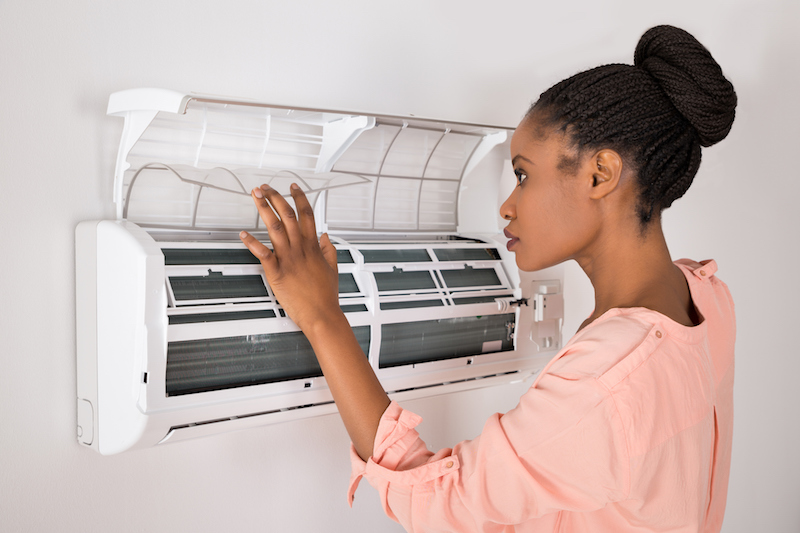
You shouldn’t have to compromise on comfort or empty your wallet to keep your residence at a refreshing temp during the summer.
But what is the right temp, exactly? We review advice from energy pros so you can find the best setting for your residence.
Here’s what we advise for the most energy-efficient setting for air conditioning in Thousand Palms.
Recommended Thermostat Settings for Summer
Most households find setting the thermostat at 72-73 degrees is most comfortable. However, if there’s a major difference between your inside and outdoor warmth, your cooling expenses will be greater.
These are our suggestions based on the U.S. Department of Energy (DOE) and ENERGY STAR®.
While at home: 78 degrees. While that seems hot, there are approaches you can keep your house refreshing without having the air conditioner going all the time.
Keeping windows and window treatments closed during the day keeps chilled air where it needs to be—inside. Some window solutions, like honeycomb shades or plantation shutters, are designed to deliver added insulation and improved energy conservation.
If you have ceiling fans in your house, the DOE says you can move thermostat temps about 4 degrees hotter without compromising comfort. That’s due to the fact they freshen through a windchill effect. As they cool people, not areas, turn them off when you exit a room.
If 78 degrees still appears too uncomfortable at first glance, try running an experiment for approximately a week. Get started by raising your setting to 78 degrees while you’re at your house. Then, progressively turn it down while adhering to the suggestions above. You may be astonished at how refreshed you feel at a warmer temperature setting.
While away: 88 degrees. There’s no rationale for keeping the air conditioner running all day while your home is unoccupied. Moving the setting 7–10 degrees warmer can save you an estimated 5–15% on your electricity costs, according to the DOE.
When you come home, don’t be tempted to set your thermostat below 78 to cool your home faster. This isn’t useful and often produces a higher cooling bill.
A programmable thermostat is a useful method to keep your settings in check, but you have to set programs. If you don’t use programs, you might forget to change the set temperature when you go.
If you want a convenient solution, consider buying a smart thermostat. This thermostat connects with your phone, so it knows when you’re at your residence and when you’re away. Then it automatically adjusts temperature settings for the biggest savings. How much exactly? Typically $180 annually on heating and cooling, according to ENERGY STAR.
Another plus of having a smart thermostat? You can use your phone to keep an eye on and adjust temperature settings from just about anywhere.
While sleeping: Around 70 degrees. While ENERGY STAR suggests 82 degrees, that could be too uncomfortable for many families. The majority of people sleep better when their sleeping area is chilly, so that’s why the National Sleep Foundation recommends 60–67 degrees. But that may be too cold, due to your PJ and blanket preference.
We recommend following an equivalent test over a week, setting your temperature higher and gradually lowering it to locate the ideal setting for your house. On cool nights, you may discover keeping windows open at night and using a ceiling fan is a superior idea than operating the air conditioning.
More Methods to Save Energy During Warm Weather
There are other methods you can conserve money on air conditioning bills throughout the summer.
- Get an energy-efficient air conditioning system. Central air conditioners only are effective for about 12–15 years and lose efficiency as they age. A new air conditioner can keep your residence comfier while keeping electricity bills low.
- Set annual air conditioner maintenance. Regular air conditioner maintenance keeps your equipment operating like it should and could help it operate more efficiently. It might also help lengthen its life expectancy, since it helps professionals to pinpoint little problems before they lead to a major meltdown.
- Replace air filters frequently. Read manufacturer instructions for changing your air filter. A clogged filter can result in your system short cycling, or run too often, and drive up your electricity.
- Measure attic insulation levels. Almost 90% of residences in the United States don’t have proper insulation, according to the Insulation Institute. Most southern climates need 13–14” of attic insulation, while northern climates require 16–18”.
- Have your ductwork checked. Ductwork that has separated over time can let conditioned air into your attic, walls or crawl space. This can create major comfort troubles in your house, such as hot and cold spots.
- Seal openings, doors and windows. Keep hot air in its place by closing holes. You can also caulk or weather strip doors to trap more cool air within your home.
Use Less Energy This Summer with Marios Air Conditioning
If you are looking to use less energy during warm weather, our Marios Air Conditioning experts can assist you. Get in touch with us at 760-766-2294 or contact us online for additional information about our energy-saving cooling solutions.
